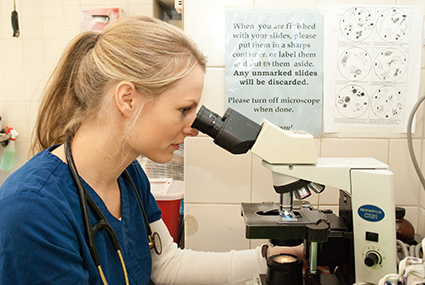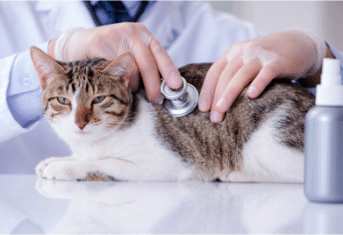Everyday Medicine: Cytology

Everyday Medicine: Cytology
“Everyday Medicine” is an intermittent series of blog posts highlighting tests, treatments, and procedures common in daily Animal Medical Center practice. Some past examples of this type of blog post include “The Highs and Lows of Blood Sugar” and “Blood Pressure.” Today’s post focuses on cytology.
Cytology is a very common exam room test performed by veterinarians. The test involves taking a sample – a swab of ear gook, a bit of diarrhea, or a few cells from a skin mass – and smearing a thin layer of the sample on a microscope slide. The slide might be dipped into a series of jars containing pink and blue dye. The dye colors the sample and helps differentiate the various cells and organisms in the sample when the slide is viewed under a microscope lens. Or, the slide might have a few drops of saline added in a procedure called a “wet mount.” In either case, the slide is then examined under a microscope to help facilitate a diagnosis.
Ear Gook
Every case of ear gook is not the same and veterinarians commonly use cytology to tell the difference between the types of ear infections. Black or brown discharge is common in ear infections and the presence of black discharge doesn’t tell us what the cause of the infection is. In cats, ear mites are really common causes of black discharge, especially in stray cats and kittens. Ear mites are not so common a cause of black discharge in dogs. Veterinarians mostly diagnose bacterial and yeast ear infections in dogs.
Yuck! Diarrhea
Diarrhea makes the pet patient uncomfortable and the pet family’s house a mess, so a quick fix is in order. A quick fix requires a quick diagnostic test like cytology. Using a “wet mount preparation” of a fresh fecal sample and a microscope, veterinarians can identify the eggs of roundworms, hookworms, tapeworms, and whipworms as well as protozoal organisms like coccidia, and Giardia. A second fecal sample may also be submitted to an outside veterinary laboratory for even more specialized testing.
Skin Masses
Another very common reason for exam room cytology is for the assessment of a skin lump. Keep in mind, a skin lump does not always mean cancer. Skin lumps can be abscesses, fluid filled cysts, benign fatty tumors, and yes, sometimes cancer. Knowing right now that I am dealing with an abscess means your cat gets the antibiotics she needs immediately. But, not every cytology sample can be evaluated in the exam room. Some samples must be sent to a laboratory where a veterinary specialist called a pathologist will interpret the cytology. Other samples indicate a biopsy is needed.
To learn more about lumps on your dog, review our previous blog post, “Will That Be One Lump or Two?”

































